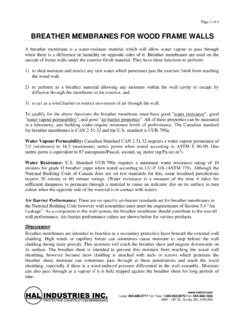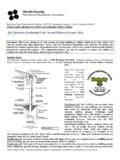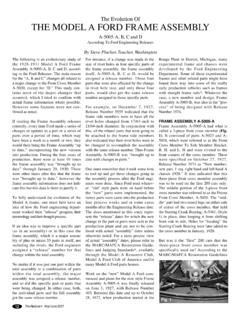Transcription of PLATE HEAT EXCHANGER Maintenance Manual - SEC Plate …
1 PLATE heat EXCHANGER Maintenance Manual Customer Name: Serial Number: Purchase order number: Project Name: 2 2 Table of Contents ---------------------------------------- ------------------------- Page: 3 Name PLATE Insert 4 Principles of the PLATE heat EXCHANGER Principles Construction of the PHE 5 PLATE Characteristics frame Components Typical Fluid Flow Construction of the Gasket Construction and Application of the frame Fluid Flow Arrangement A to B Configuration Typical PLATE Arrangements Single Pass 11 Typical PLATE Arrangements Multi Pass 12 Disassembling a Unit 13 Reassembling a Unit 14 Cleaning Cleaning in Place (CIP) 15 Cleaning of Edible Oil 16 Tightening Devices 17 Transportation and Installation of the PHE 18 General Operating Instructions Re-gasketing General Instructions for Glued Gaskets 19 Long Term Storage Spare Parts Numbering System Gasket Code System 20 Plates with Gasket Code System frame Component Code System 21 Trouble Shooting Excessive Temperatures Steam 22 Excessive Pressure and Spikes Design Pressure Pressure Spikes 23-24 Fluid Incompatibility Leak Detection and Elimination 25 Service History Log Addendum 1 Unit Drawing and Data Sheet 3 NAME PLATE : To assist us to reply to questions please quote your Serial Number: DATE BUILT UNIT TYPE SERIAL N O.
2 SURFACE AREA DESIGN PRES S . DESIGN TEMP. TEST PRESS. EMPTY WEIGHT PLATE MAT L . GASKET MAT L CHANNEL ARRANGEMENT X PASS NO. ORIGINAL TIGHTENING DISTANCE WORK COVER APPROVAL No. SEC heat Exchangers 2546 Iona Road, Belfast PEI, Canada, C0A 1A0 Tel: - Fax: Email: PROCESS S I D E SERVICE SIDE 4 1. PRINCIPLE OF THE PLATE heat EXCHANGER (PHE) 1-1. PRINCIPLE The PHE is composed of corrugated thin alloy plates, which are hung between top and bottom guide bars. The plates are compressed by bolts between fixed and movable frames, until metal to metal contact is reached and a channel is formed.
3 The manner in which the gaskets are fitted enables alternative flow channels to be created and heat transfer to pass from one side of the PLATE to the other. The alternative channels maximises the heat transfer surface in a compact manner. Therefore, it can produce the most effective performance from the compact size. CONSTRUCTION OF THE PLATE heat EXCHANGER GUIDE BAR (CONNECTION PART OF THE GUIDE BAR) FLUID CHANNEL GASKET heat TRANSFER AREA RING GASKET Fig. 1 PLATE ( MAIN FEATURES OF A heat TRANSFER PLATE ) 5 PLATE CHARACTERISTICS PLATE thickness is normally in the range Stainless steel, Titanium, Hastelloy, Copper-Nickel and Al-brass are available. The plates are pressed to form corrugations which increase the surface area and strength of the plates. The PLATE has up to four connection holes for fluid transfer, with gaskets fitted to confine the liquids.
4 Gaskets are made from composed rubber and are chosen in accordance with the types of fluids to be used in the PHE. The corrugated shape on the plates maximises the heat transfer efficiency by creating high turbulence in the channels. Centrally located cut outs on the top and bottom ends of each PLATE is designed to make the PLATE hang correctly either side to the top and bottom guide bars. HERRINGBONE TYPE 6 frame COMPONENTS PART QTY DESCRIPTION PART QTY DESCRIPTIONFRAME PLATE 1 CARBON OR STAINLESS heat TRANSFER PLATE * ALLOY PRESSURE PLATE 1 CARBON OR STAINLESS TIGHTENING BOLT * HIGH TENSILE SUPPORT COLUMN 1 CARBON OR STAINLESS NAME PLATE 1 STAINLESS UPPER GUIDE BAR 1 CARBON OR STAINLESS CONNECTION NOZZLE * STAINLESS LOWER GUIDE BAR 1 CARBON OR STAINLESS DRAIN VALVE * STAINLESS DETERMINED BY UNIT TYPE AND DESIGN 7 TYPICAL FLUID FLOW Guide BarSupport Column Tightening Bolt Fixed frame heat Transfer PLATE Gasket Carry Bar Moveable Pressure PLATE 8 CONSTRUCTION OF THE GASKET The gaskets are designed as a duplicate structure to prevent mixing the fluids.
5 Should the ring gasket fail the liquid vents to the atmosphere ( B part), and is prevented from mixing with the opposing liquid by the diagonal gasket. In a similar manner if the diagonal gasket fails the ring gaskets acts as a secondary seal. CONSTRUCTION AND APPLICATION OF THE frame The construction of the frames is dependent on the application, pressure requirements and the type of the plates held in the frame . The frames are protected from the liquids due to the welding or pressing of liners into the appropriate connection. In general terms the construction and operation of the frames is the same for all PHE S 9 FLUID FLOW ARRANGEMENT A to B CONFIGURATION Forming of the PLATE pack channels is accomplished by hanging the plates (gasketed plates should be faced to the frame ) in alternative A then B fashion. As can be seen in , the PLATE which has the ring and diagonal gasket on the right hand side and chevron pattern pointing down, the PLATE is called the 'A' PLATE and when rotated becomes the 'B' PLATE .
6 One fluid flows on the surface of each of the 'A' plates, while the alternative fluid flows over the 'B' PLATE . FIG: 6 The flow directions are normally counter current to each other. The hot fluid flows with two parallel lines, top to bottom and bottom to top, and the cold fluid with 4 parallel lines flows bottom to top. The PLATE arrangement can be written as 2 x 2 + 1 4 x 1 where + 1 represents the end PLATE which does not perform any heat transfer. The four holes in the PLATE are distinguished as 1, 2, 3, and 4 from their positions, and '0' means no hole. There are 16 hole combinations possible depending on the application and temperature approach. 'A' PLATE BAA'B' PLATE BAB 10 TYPICAL PLATE ARRANGEMENTS EXAMPLE OF PLATE ARRANGEMENT AND FLOW SINGLE PASS ARRANGEMENT SINGLE AND MULTI PASS ARRANGEMENT 11 ADDITIONAL PLATE ARRANGEMENTS MULTI PASS ARRANGEMENT SINGLE & MULTI- MULTI PASS ARRANGEMENT 12 DISASSEMBLING A UNIT Remove frame : 1) Remove any foreign material and apply grease to all bolts.
7 2) Loosen the intermediate bolts and remove from the frame . 3) Loosen the diagonals in sequence to maintain the pressure PLATE parallel to the frame PLATE . Caution Never allow the pressure PLATE to be at an angle to the PLATE pack as the plates maybe distorted, due to excessive loading. To Disassemble the plates: 1) Remove any foreign material and apply grease to the top guide bar for easier movement of the plates. 2) Remove each PLATE one at a time in the direction of the arrows as shown, ensuring that the gasket is not held onto the PLATE in front of it. heat EXCHANGER WITH TWO CONNECTIONS 13 RE-ASSEMBLING THE UNIT - The first PLATE is the A PLATE followed by a B PLATE , until all plates are hanging in the frame . - Re-assemble the unit in the opposite sequence of disassembling see bolt tightening sequence below 14 CLEANING Follow the next sequence to clean the plates after disassemble.
8 1) Clean the plates one by one with high pressure water or chemical clean in an appropriate acid or caustic. 2) Remove clip-on gaskets and ensure the gasket groove is clean before reattaching the gasket. Any foreign material left will cause the gasket to leak on resealing of the unit. (3) Cleaning the gasket. Do not use a steel brush or the gasket will be marked and a leak will occur on re-tightening of the unit. Mild soap or water should be used with a cloth (4) Should your unit have a corrosive duty, ensure that any opening of the unit is keep to a minimum. This will prevent excessive swelling of the gasket. Ask your heat EXCHANGER supplier for more details on applicable duties. 5) Removing Calcium Deposition (Ask your heat EXCHANGER supplier for details). 5-1) Submerge the PLATE in phosphoric or nitric acid (nitric acid of specific gravity , 1 litre + water 10 litres ) for 5-10 minutes at normal temp and rinse wash with water.
9 Acid cleaning passivate the PLATE with a neutraliser such as caustic and again rinse clean with water. Cleaning in Place (CIP) (Ask your heat EXCHANGER supplier for details.) An alternative cleaning method is CIP cleaning which does not require the disassembling of the PLATE pack see. - Cleaning Brine: - the brine should be expelled completely and then run the system with pure water at normal flow rates, until the unit is clean. Cleaning brine with hot water, follow the sequence above and loosen the retaining bolts for gasket's expansion 100 plates / 5mm. The flow rate of the cleaning water should be higher than the duty flow rate for maximum affect. In chemical cleaning, the temperature and density of caustic are not that critical but for nitric or phosphoric acids, higher temperatures accelerate the acids activity. Nitric acid should not be used on any material, except stainless steel.
10 If the PH of the acid falls below 5, adjust to over 7 for improved performance. 15 Cleaning of Edible Oil. heat exchangers on food duties should be cleaned every day, a suggested method is. - Discharge the fluid with water and monitor the situation through the glass tube. - Pass pure water through the heat EXCHANGER for 5-10 minutes. - Circulate 70 litres water for 20-30 minutes. - Circulate 60-70 litres, nitric acid for 30 minutes. - Circulate pure water to flush out any material. - Neutralise the plates with 60-70 litres caustic for 30-60 minutes. - Circulate pure water again. ? Caution Take care that the temperature and density of the nitric acid does not exceed the limitations above. The cleaning sequence, nitric treatment and caustic cleaning, can be changed but there must not be any residual acid left in the unit. Nitric acid should not come in contact anything except stainless steel.







